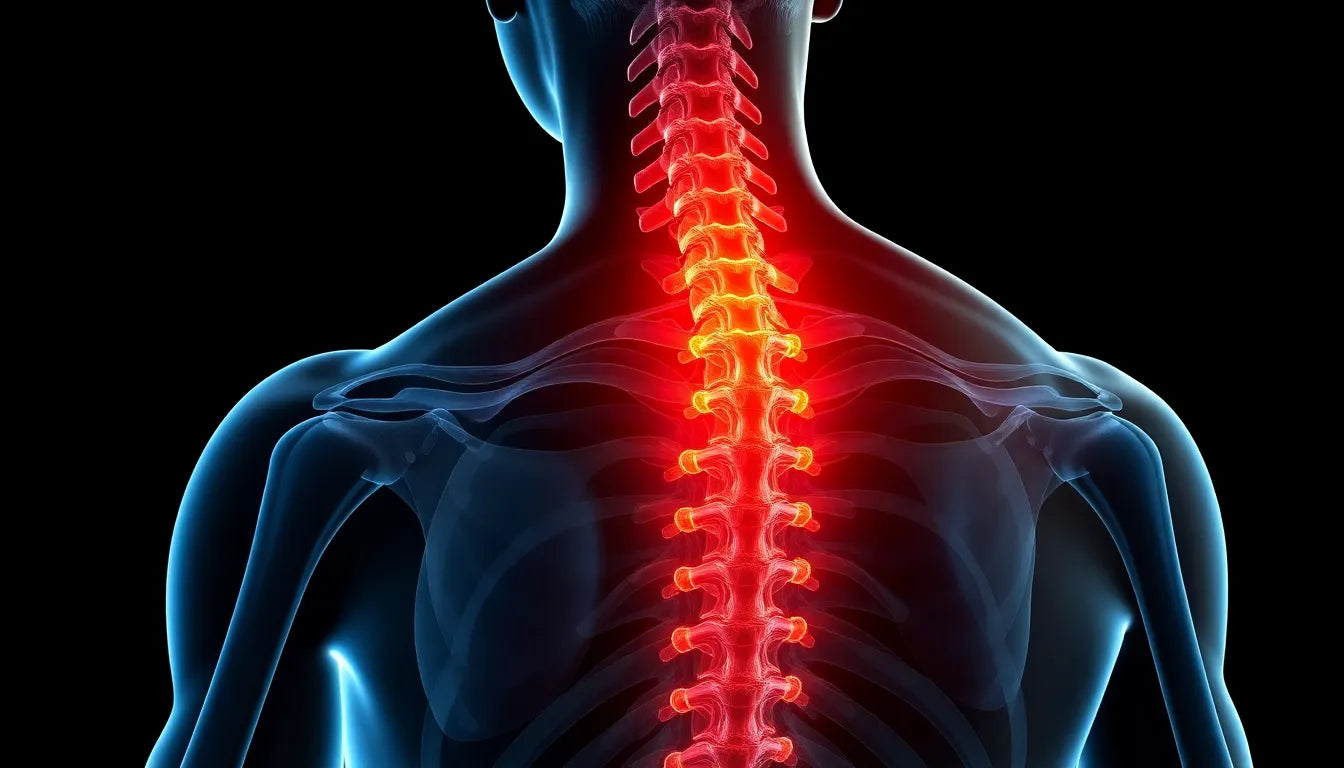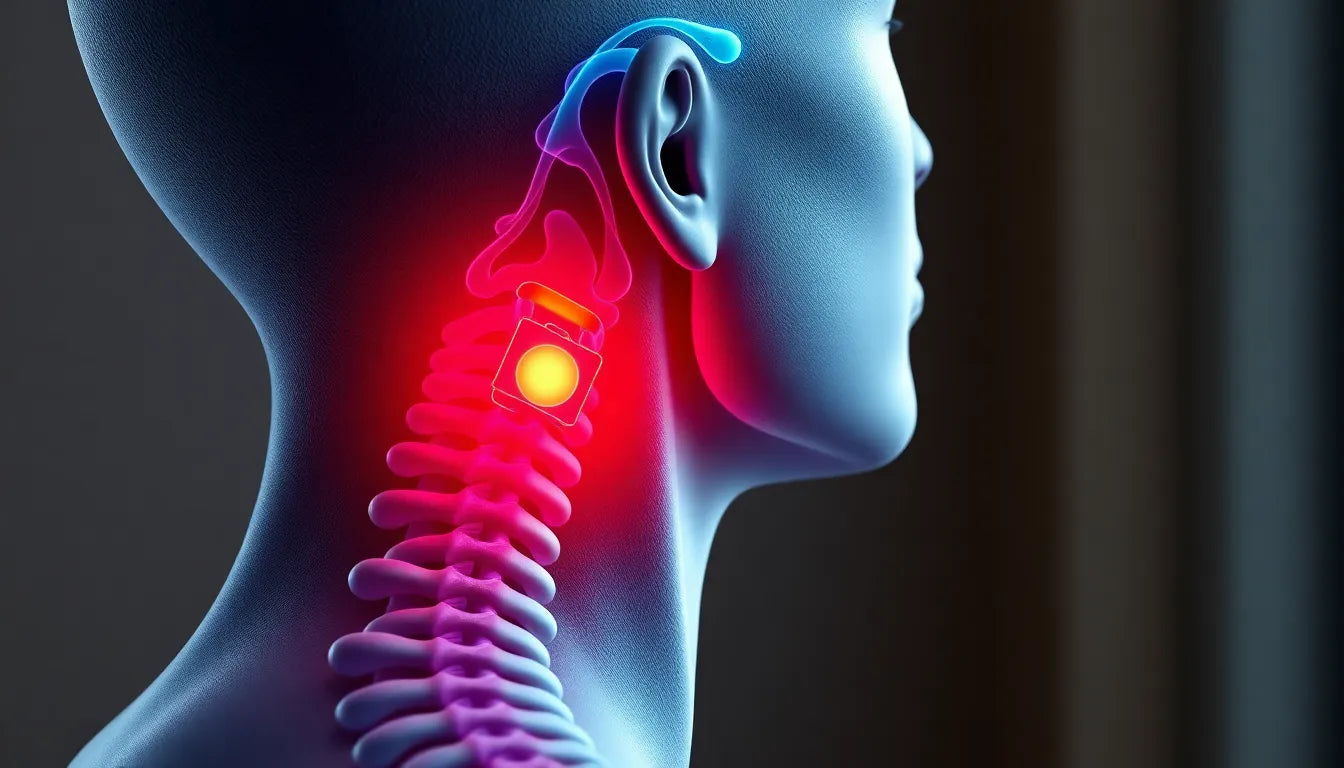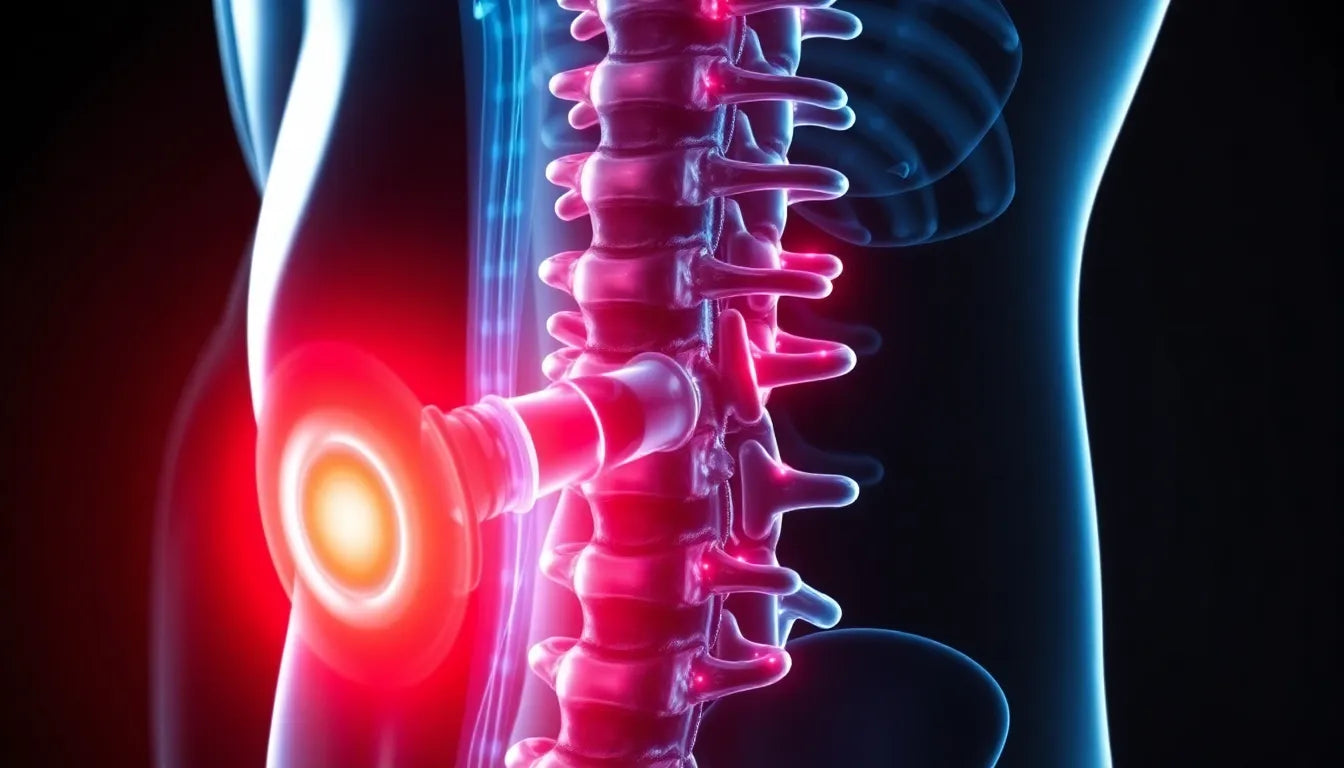Imagine waking up to a sharp, burning pain between your shoulder blades that just won't go away. This discomfort can be both alarming and debilitating, affecting your daily life and productivity. If this scenario sounds familiar, you might be dealing with a herniated disc in the thoracic spine. Understanding the symptoms and causes of this condition is crucial for effective management and relief.
A herniated disc, often referred to as a slipped or ruptured disc, occurs when the soft inner gel of a spinal disc pushes through a tear in its tougher outer layer. While herniated discs are more common in the lower back, they can also occur in the thoracic spine, the region between your shoulder blades. This area of the spine is less flexible than the lower back, making herniated discs here less common but potentially more painful and complex to treat.
Understanding the thoracic herniated disc
The thoracic spine consists of 12 vertebrae, and a herniated disc in this region can lead to symptoms that are distinct from those in other parts of the spine. The condition can cause localized pain between the shoulder blades, and in some cases, the pain may radiate to the chest or abdomen. This is due to the unique nerve pathways in the thoracic region, which can sometimes mimic other medical conditions, making diagnosis challenging.
The purpose of this article is to provide a comprehensive understanding of the symptoms, causes, and potential treatments for a herniated disc between the shoulder blades. By recognizing the signs early and understanding the underlying causes, individuals can seek appropriate medical advice and explore effective treatment options to alleviate pain and improve quality of life.
In the sections that follow, we will delve deeper into the specific symptoms associated with a herniated disc in the thoracic spine, explore the common causes, and discuss both non-surgical and surgical treatment options available to manage this condition effectively. Whether you are experiencing these symptoms yourself or are simply looking to understand more about spinal health, this guide aims to equip you with the knowledge you need to take informed steps towards relief and recovery.
Recognizing the symptoms of a herniated disc between the shoulder blades
A herniated disc in the thoracic spine can manifest through a range of symptoms that vary in intensity and character. One of the most common signs is a sharp pain that feels like an electric shock or a burning sensation. This pain is typically localized in the upper back and shoulder blade region, but it can also radiate to other parts of the body, such as the chest or abdomen, depending on the nerve pathways affected.
In addition to pain, individuals may experience numbness and tingling. These sensations often extend to the arms or fingers, indicating that the herniated disc is compressing or irritating nearby nerves. This nerve involvement can lead to muscle weakness in the arms or upper back, making it difficult to perform everyday tasks that require strength and coordination.
Types of pain associated with a herniated disc
Understanding the different types of pain that can occur with a herniated disc is crucial for accurate diagnosis and treatment. Discogenic pain originates directly from the damaged disc itself. It is often described as a deep, aching sensation that can be persistent and difficult to relieve.
Radicular pain, on the other hand, follows the path of the affected nerve. This type of pain is typically sharp and shooting, radiating from the spine to other areas, such as the arms or chest. It is often exacerbated by certain movements or positions that put additional pressure on the nerve.
Lastly, muscle spasms can occur as a result of the body's attempt to stabilize the affected area. These involuntary contractions can increase discomfort and restrict movement, further complicating the condition.
Identifying the causes of herniated discs in the thoracic spine
Several factors contribute to the development of herniated discs between the shoulder blades. One of the primary causes is aging and degeneration. As we age, the discs in our spine naturally lose water content and elasticity, making them more susceptible to tears and herniation.
Injuries and accidents can also lead to herniated discs. Sudden impacts, such as those experienced in car accidents or falls, can cause the disc to rupture or bulge, leading to pain and other symptoms.
There is also a genetic component to consider. Some individuals may be predisposed to disc problems due to inherited traits that affect the structure and integrity of their spine.
Impact of lifestyle factors
Lifestyle choices play a significant role in the health of your spine. Poor posture, for instance, can place undue stress on the thoracic spine, increasing the risk of disc herniation. Similarly, repetitive strain from certain activities or occupations can weaken the discs over time, making them more prone to injury.
Understanding these causes is essential for prevention and management. By addressing lifestyle factors, such as maintaining good posture and avoiding repetitive strain, individuals can reduce their risk of developing a herniated disc and manage existing symptoms more effectively.
In the next section, we will explore the various diagnostic techniques and treatment options available for managing herniated discs in the thoracic spine. From non-surgical methods to surgical interventions, understanding these options is key to finding relief and improving your quality of life.
Diagnosis and treatment options for herniated discs between the shoulder blades
When it comes to diagnosing a herniated disc in the thoracic spine, medical professionals rely on a combination of clinical assessments and advanced imaging techniques. A thorough physical examination is often the first step, where doctors assess your range of motion, reflexes, and any areas of tenderness. During this examination, they may ask you to perform specific movements to evaluate pain and nerve function.
For a more definitive diagnosis, medical imaging tools like MRI (Magnetic Resonance Imaging) and CT (Computed Tomography) scans are invaluable. These imaging techniques provide detailed views of the spine, allowing doctors to pinpoint the exact location and severity of the herniation. An MRI is particularly effective in showing soft tissue structures, such as discs and nerves, while a CT scan offers detailed images of the bone structures.
Non-surgical treatments
Once a herniated disc is diagnosed, treatment typically begins with non-surgical options. These methods aim to relieve pain, reduce inflammation, and improve mobility without the need for invasive procedures. Medications such as pain relievers and anti-inflammatories are commonly prescribed to manage discomfort and swelling. In some cases, muscle relaxants may be recommended to alleviate muscle spasms.
Physical therapy plays a crucial role in the rehabilitation process. A physical therapist can design a personalized exercise program to strengthen the muscles around the spine, improve flexibility, and enhance overall spinal stability. These exercises help reduce pressure on the affected disc and promote healing.
Additionally, making lifestyle changes can significantly impact recovery and prevent future issues. Practicing good posture, especially during activities that strain the back, is essential. Ergonomic adjustments in the workplace and at home can also help maintain proper spinal alignment and reduce stress on the thoracic spine.
Surgical options
While most cases of herniated discs can be managed with non-surgical treatments, surgery may be necessary for severe or persistent cases. Surgical intervention is typically considered when conservative methods fail to provide relief, or if there is significant nerve compression leading to severe pain or neurological deficits.
Common surgical procedures for herniated discs include discectomy, where the herniated portion of the disc is removed, and spinal fusion, which stabilizes the spine by fusing two or more vertebrae together. The decision to undergo surgery should be made in consultation with a spine specialist, who can assess the risks and benefits based on individual circumstances.
Frequently asked questions
What are the symptoms of a herniated disc in the upper back?
Symptoms typically include sharp pain, numbness, tingling, and muscle weakness in the upper back and arms. The pain may feel like an electric shock or burning sensation and can radiate to other areas.
How is a herniated disc between the shoulder blades diagnosed?
Diagnosis involves a combination of a physical examination and imaging tests such as MRI or CT scans. These tools help doctors visualize the spine and identify the location and severity of the herniation.
Can a herniated disc heal on its own?
In many cases, symptoms can improve over time with non-surgical treatments such as medication and physical therapy. However, severe cases may require medical intervention to prevent further complications.
What lifestyle changes can help manage symptoms?
Maintaining good posture, engaging in regular exercise, and avoiding activities that strain the back can help manage symptoms. Ergonomic adjustments at work and home are also beneficial for spinal health.
Understanding the symptoms, causes, and treatment options for a herniated disc between the shoulder blades is essential for effective management and relief. By taking proactive steps and seeking appropriate medical care, individuals can alleviate pain and improve their quality of life.























